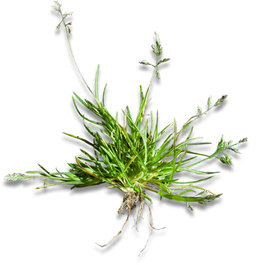Annual meadow grass, the nightmare of every greenkeeper and field manager
 Annual meadow grass (Poa annua) is one of the most common grass species. It is an annual, sometimes biennial and occasionally perennial meadow grass (Poa) with shallow roots. Annual meadow grass flowers at an early stage, and its height does not exceed 25-30 cm. However, this plant will usually remain much shorter.
Annual meadow grass (Poa annua) is one of the most common grass species. It is an annual, sometimes biennial and occasionally perennial meadow grass (Poa) with shallow roots. Annual meadow grass flowers at an early stage, and its height does not exceed 25-30 cm. However, this plant will usually remain much shorter.
How to recognise annual meadow grass

Annual meadow grass is usually easy to identify. The youngest leaf will appear in a folded shape. There are no auricles at the base of the leaf, and the underside of the unribbed leaf is matte and often pale green in colour. This colour difference is often clearly visible in a field. Furthermore, Poa annua has a long and milky-white ligule. In a field, annual meadow grass can easily be identified by its abundant seed formation. After all, it flowers year-round. The leaves are unribbed, which means that they are soft and wavy.
Low wear tolerance
The wear tolerance of annual meadow grass is moderate to low, partly for reason of its shallow roots. This means that the grass is easily kicked or hit away, which may result in many bare spots that will significantly reduce the quality of play on a sports field or golf course. In addition, annual meadow grass has an unattractive appearance.
 Appearance of annual meadow grass
Appearance of annual meadow grass
The appearance of annual meadow grass is unattractive. Poor nutrition will change its mid-green colour to a lighter green. The colour will change in dry conditions and when there is insufficient moisture in the top layer, annual meadow grass will immediately turn light green and then begin to flower profusely.
Early germination
Annual meadow grass germinates at soil temperatures as low as 7 - 8 °C. When the fields have been played bare, annual meadow grass will often be the first to appear as most grass mixtures germinate at higher temperatures. This means that the bare patches are filled in fast and the good thing is that there is a green cover, which is always better than nothing. However, this benefit does not outweigh the disadvantages. Annual meadow grass can be tackled by, for example, SOS from Barenbrug. SOS germinates at approx. 4 °C, which means that it is virtually impossible for annual meadow grass to establish itself.
Not sustainable
In recent years, sustainable control of grass has increased significantly in importance. Annual meadow grass needs large quantities of water and fertiliser. Sustainable grass management is not possible with annual meadow grass. Environmental damage is therefore the result of this grass plant.
A major stress factor for annual meadow grass is drought. Its reaction to drought is to flower profusely, and all these flowering tufts don’t do much for the visual appeal of the field. Stress factors cause annual meadow grass to reproduce. It will try to maintain itself by producing seed heads. When this happens a lot, there is no stopping annual meadow grass and it will appear everywhere.
Annual meadow grass is very susceptible to diseases. Fusarium and Dollar Spot are the most occurring diseases in fields that contain annual meadow grass. These diseases can seriously damage a field.
Tolerates close mowing
Annual meadow grass can even flower at a mowing height of 0.5 cm or lower and deliver germinable seed, and several times a year! Many grasses do not survive close mowing, but annual meadow grass does.
Thatch build-up
Naturally, extended rainfall leads to the formation of a wet top layer. A wet top layer is more sensitive to compaction than a dry one. Wet conditions hinder the decomposition of dead stalks and roots, and this results in a thick thatched, matted layer. The a situation occurs in which annual meadow grass can grow with ease because of its shallow roots. The thatch prevents water from reaching the unsaturated areas, which in turn may lead to water problems.
Control of annual meadow grass
Most grass mixtures lose the battle against annual meadow grass. This is due to the very fast germination of annual meadow grass. It germinates and establishes itself faster than most grass mixtures. However, at Barenbrug we have mixtures that are even faster. For example: the powerful RPR, characterised by its very fast germination and ability to create an extremely strong grassed surface, which makes it virtually impossible for annual meadow grass to grow. Read more about RPR here.
Another solution is SOS. This is an excellent product, especially in the winter months as it germinates at a temperature as low as 4 °C. This is sooner than annual meadow grass, which germinates at around 8 °C. SOS is therefore another serious challenger of annual meadow grass. Read more about SOS here.
Nightmare of the greenkeeper and field manager
Annual meadow grass will fill in a field very quickly, and it is green. However, this is the only benefit annual meadow grass provides and it certainly does not outweigh all the aforementioned disadvantages. Annual meadow grass, with all its negative consequences, can cause the greenkeeper and field manager many sleepless nights.
For information about annual meadow grass on golf courses, click here.




